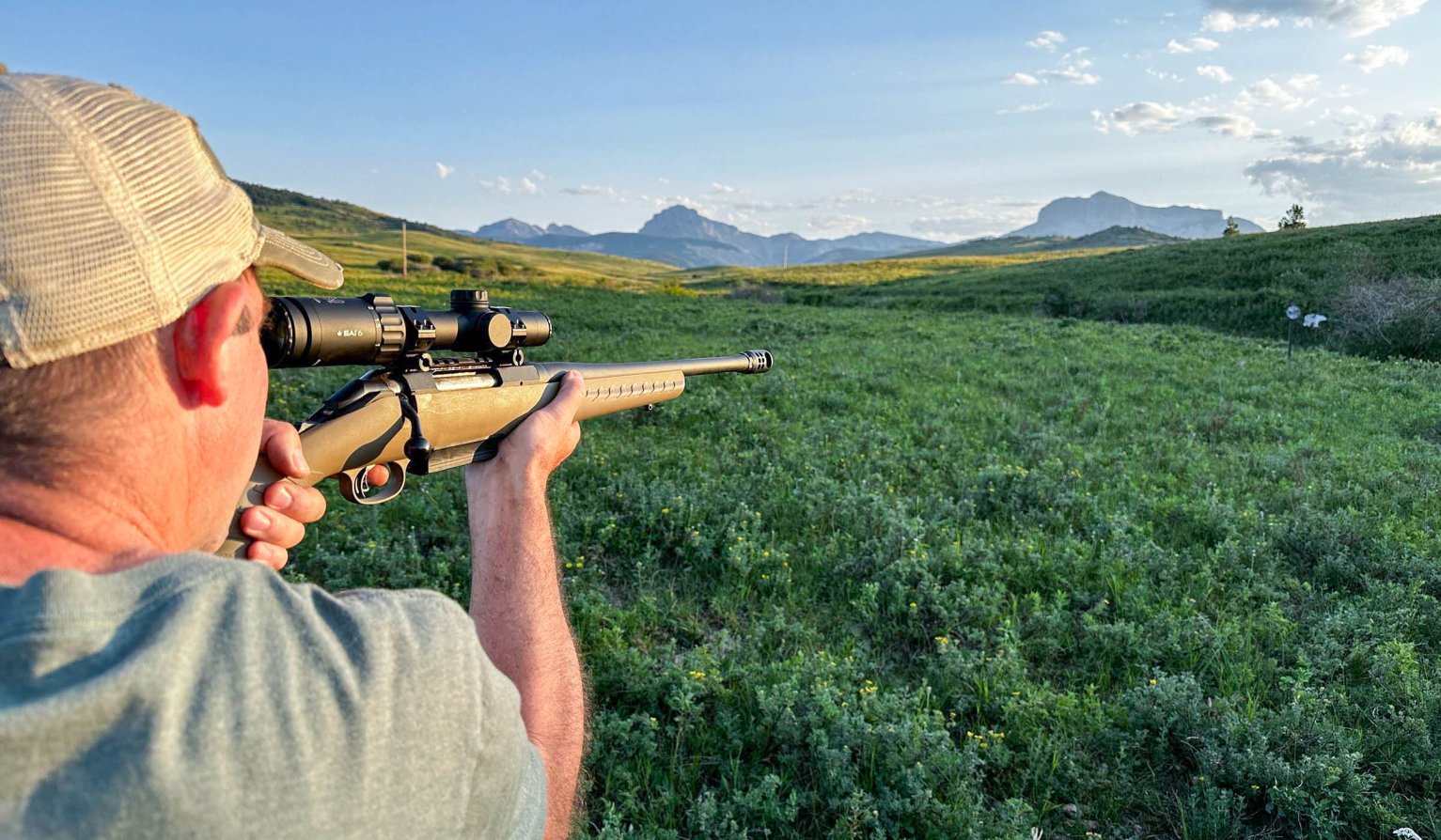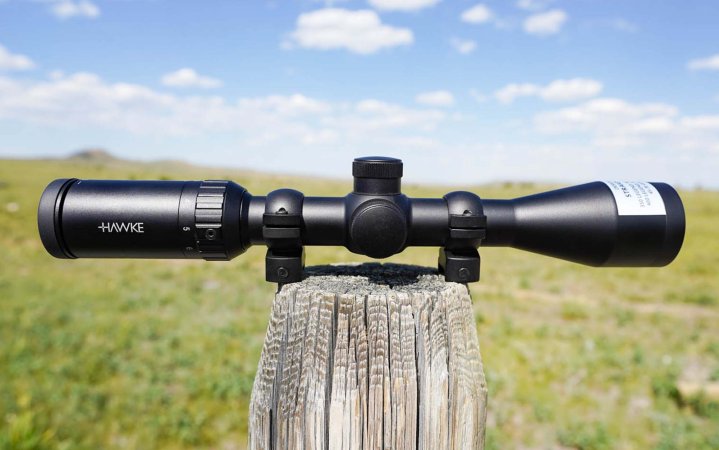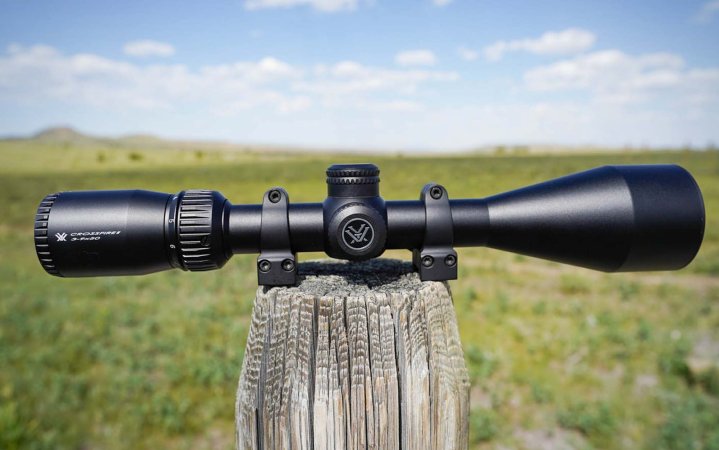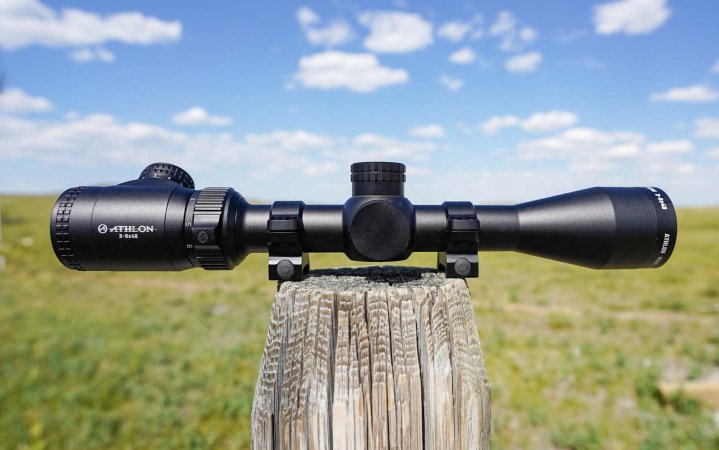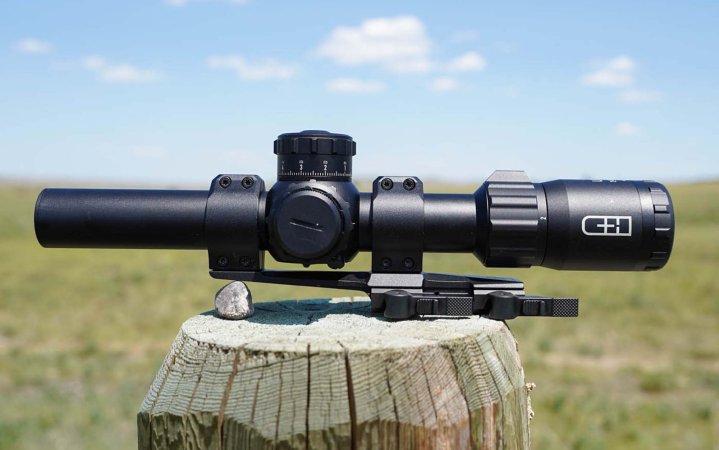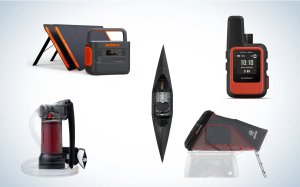We may earn revenue from the products available on this page and participate in affiliate programs. Learn More ›
As the straight-wall cartridge revolution crawls across whitetail country — with more states allowing mid-range modern rifles in their deer seasons — it was only a matter of time before optics brands capitalized on the new and emerging market.
At least three brands have repurposed versatile mid-power scopes for straight-wall cartridge hunters and shooters. It’s not that the glass, controls, or configuration is new, but each of these scopes has a reticle that’s designed for the ballistic drop of standard straight-wall cartridges. It’s a critical consideration, as the relatively heavy, slow-moving bullets drop quickly, making standard BDC or hash-style reticles imperfect choices for the bullet drop of 450 Bushmasters, .45/70 Gov’t, and 350 Legends.
We wanted to put three caliber-specific scopes up against one another in this year’s Outdoor Life Optics Test, and while we evaluated them just as we would any other scope, by shooting them, testing their glass, and controls, we added a fun shoot-off that really showed us the merits and shortcomings of each submission.
My ride-around truck gun is a Ruger American chambered in 450 Bushmaster. I realize that’s a lot of gun for a ranch rifle, but its main job is to put down injured cows. At the test, we used the Bushmaster as a dangerous-game rifle to test the snap-shooting capabilities of our field of LPVOs.
But the Ruger proved its worth on our straight-wall scope test. Shooting Remington’s 260-grain Premier AccuTip, we zeroed the scopes at 100 yards, and then, shooting from a bench, used their reticles to ring steel at 200 and 300 yards, then returned to zero and tested the speed, visibility, precision, and overall utility of the reticles.
Here’s what we discovered.
- Editor’s Choice: Hawke Vantage IR Straight-Wall Marksman 3-9×40
- Best All-Around: Vortex Crossfire II 3-9×50
- Best Value: Athlon Neos Straight-Wall 3-9×40
- Best LPVO: C&H LPVO 2-12×24
The Best Staight-Wall Rifle Scopes: Reviews and Recommendations
Editor’s Choice: Hawke Vantage IR Straight-Wall Marksman 3-9×40
Score Card
- Optical Performance: Good
- Mechanical Performance: Very Good
- Design: Good
- Price/Value: Very Good
Key Features
- 1-inch tube
- Second-plane Straight-Wall Marksman BDC MOA-based reticle
- Capped turrets with .25 MOA adjustment
- 100 MOA total windage/elevation adjustment range
- 10-step red/green illumination
- Optimized for 450 Bushmaster, .45/70 Gov’t, 350 Legend, and 400 Legend
- Parallax set at 100 yards
Pros
- Reticle has easy-to-see distance references
- Good mounting dimensions
- Handy illumination
- At about $220, a fair price
Cons
- Turrets are small and indistinct
- Turrets aren’t re-zeroable
- Turrets aren’t properly indexed
This scope absolutely ruled our shoot-off, thanks to a clear and useful reticle that literally gives shooters specific hold-over directions. You want to zero at 100 yards? The reticle has a 100-yard reference, with the number etched on the reticle. There are other numeric etching at 150, 200, 250, and 300 yards. I know what you’re saying: all those numbers probably clutter the view.

You’re not wrong; the references are a little busy. But our testers found them to be fast, precise, and idiot-proof.
“I was skeptical about lobbing a 300-grain bullet out at 300 yards, but I just held where the scope told me and rang steel on my first shot,” noted tester Dale Manning. “It’s precise, but it’s also really fast in real-world field conditions.”
The very specific references that make this the best straight-wall cartridge scope in our test limit its wider utility. Those etched bullet drops aren’t going to help a rimfire shooter or a hunter who’s using a .30/06 or 6.5 Creedmoor. And testers hated the Hawke’s turrets, which are small and hard to turn and they lack indexing.
But if you’re in the market for a scope that will lob bullets surprisingly precisely, from both 350 and 400 Legends, 360 Buckhammer, 450 Bushmaster, and .45/70 Gov’t, this is absolutely the scope for you.
Read Next: Best Straight-Wall Deer Rifles

Best All-Around: Vortex Crossfire II 3-9×50
Score Card
- Optical Performance: Very Good
- Mechanical Performance: Good
- Design: Good
- Price/Value: Very Good
Key Features
- 1-inch tube
- Second-plane Straight-Wall BDC MOA-based reticle
- Capped turrets tuned to .25 MOA values
- 60 MOA total windage/elevation adjustment range
- Optimized for 450 Bushmaster, .45/70 Gov’t, and .350 Legend
- Parallax set at 100 yards
Pros
- Bullet drop references informed by Vortex Ballistic Calculator
- Good mounting dimensions
- 50mm lens enables good light transmission
- Aced our turret tracking test
- At about $200, a good price
Cons
- No illumination
- Reticle references are small and imprecise
- Spongy turret clicks
Consider the real world of straight-wall deer hunting. It’s a world of brush and limbs and the murky light of Midwest Novembers. In this particular world, you want your scope to have a bold, easy-to-see reticle, because deer are cryptic and don’t wait around for you to parse reticle references.

In this regard — reticle utility — the Vortex doesn’t bring much to the game. In order for the second-plane reticle’s ballistic drops to work, the scope has to be at its highest magnification, further reducing the amount of light that reaches your eye. With a 100-yard zero, the Crossfire II gives you a barely visible hash at 200 yards, a slightly wider hash at 300, and another tiny reference at 400 yards. That’s simply not enough. Reticle references should be both bolder and better defined.
But, if we set aside our complaints with the reticle, the rest of the scope has a lot to offer. The turrets, while mushy, are re-zeroable. The 1-inch tube has liberal mounting dimensions. The 50mm objective gave the Vortex the best optical performance of our mini straight-wall scope test and helps with target acquisition at the scope’s highest magnification.

The reason we give the Vortex the Best All-Around Straight-Wall Scope award is because it’s a legitimate rimfire and versatile center-fire scope. “It’s a good gopher scope,” notes tester Ky Idler. Buy it for your 450 Bushmaster, .45/70 Gov’t, and 350 Legend, but keep it for all your other rifles. That’s the very definition of versatility.
Read Next: Best Hunting Scopes
Best Value: Athlon Neos Straight-Wall 3-9×40
Score Card
- Optical Performance: Fair
- Mechanical Performance: Good
- Design: Good
- Price/Value: Very Good
Key Features
- 1-inch tube
- Second-plane BDC 300 Straight-Wall reticle
- Ballistic drops tuned to specific straight-wall calibers and bullets
- Red LED center-cross illumination
- Capped turrets tuned to .25 MOA values
- 80 MOA total windage/elevation adjustment range
- Parallax set at 100 yards
Pros
- With proper zero and bullets, reticle references are fast and precise
- Low mounting dimension fit a variety of rifle receivers
- One of few entry-level straight-wall scopes with illumination
- At about $175, a fair price
Cons
- Illumination module is large and ungraceful
- Reticle references are small and imprecise
- Spongy turret clicks
None of the straight-wall scopes in our mini test are particularly pricey, but this model from Athlon offers a number of appealing attributes, places heavy bullets on target out to 300 yards, and costs around $175, making it the best value in our collection.
Like its competitors, the Neos doesn’t have memorable glass or controls. But that’s not why you’re buying this. You are looking for an inexpensive get-‘er-done optic, and the Athlon lives up to that expectation. Its BDC 300 Straight-Wall illuminated reticle lives up to its promise as a decent 300-yard punkin-lobber. The reticle, basically a modified duplex, also has hashes for hold-offs in 5- and 10-mph right-angle winds, but we didn’t test the veracity of those references.

Like the other second-plane reticles in this mini-test, the Athlon’s reticle drops work only at the highest magnification, but at 9-power the scope handles well, providing good magnification of the target and decent light transmission. The reticle, though, is too fine; we’d like to see the elevation stadia and bullet-drop dots a little heavier. Red illumination helps visibility, but the illumination module, awkwardly located on the scope’s eyepiece, is clunky and graceless, though easy to reach to turn on and off.
The Athlon’s capped turrets are fairly crisp, and are re-zeroable, though we’d like to see bolder and more visible indexing on the dials. The scope’s parallax is fixed at 100 yards. The 1-inch main tube has plenty of space for various mounting options, and the 40mm objective allows for low-profile mounting. While the scope’s reticle is tuned to very specific straight-wall cartridge bullets (250-grain Hornady FTX in 450 Bushmaster, 325-grain FTX in .45/70 Gov’t, 150-grain Winchester Extreme Point in 350 Legend, and 200-grain Remington Core Lokt in 360 Buckhammer), the scope would be fine on a rimfire or modern center-fire rifle.
At $179 retail price, we reckoned the Neos brings a lot to the straight-wall party, and wins our Great Buy award in this small and tightly defined category of versatile scope.
Best LPVO: C&H LPVO 2-12×24
Score Card
- Optical Performance: Good
- Mechanical Performance: Very Good
- Design: Very Good
- Price/Value: Fair
Key Features
- 30mm tube
- First-plane FFP circle-dot reticle
- Exposed pull-to-turn re-zeroable and zero-stoppable turrets
- Turrets tuned to .1 MRAD clicks
- 34 MRAD internal adjustment
- Six-step LED center-circle illumination
- 10 yards to infinity side parallax adjustment
Pros
- Extremely versatile reticle
- 2- to 12-power zoom range perfect for whitetail hunting
- Bombproof build
- At 10-12X, reticle has very useful holdover and hold-off references
- Mountable on AR carbine, lever gun, or bolt guns
Cons
- Reticle references not very visible until 6X
- At $1,349, a pricey scope
This freshman effort from C&H, a brand more familiar to readers as an AR-accessories business, is built with the precision shooter in mind, but it has a ton of talent as a straight-wall cartridge scope.

First, its excellent reticle has caliber-agnostic references. For shooters spun up on milling, and adept at using .5 MRAD references, this reticle can drop heavy straight-wall slugs into targets at any distance or wind value. C&H’s first-plane circle-dot reticle makes an excellent snap-shooting rig at lower magnifications, especially with the center-circle blazingly illuminated. At higher magnifications, from about 8X to 12X, the reticle’s references guide precision shooters.
The scope is built for dialing, with big, beefy exposed turrets that lock positively but lift to turn with precise, tactile authority. Both turrets are re-zeroable, and the elevation turret has a stout zero stop.
The reticle is a little busy for most hunting situations, and users will have to practice in order to parse their target from the grid of reticle dots and hashes. And we found the C&H controls to be a bit too stiff for fast field deployment, but we expect the turrets and power ring to loosen with a season of honest use. The side parallax is nice, and its ability to focus as close as 10 yards makes this a great air gun or rimfire scope. But we’d be just as happy with a fixed 100-yard parallax.
The reason this tactical scope is included in our straight-wall test is because its configuration offers a little more magnification than standard LPVOs and is built to handle the rigors of a late-season deer hunt. Its reticle, too, is a very good alternative to caliber-specific second-plane reticles that lock users into a single load. The C&H can be used on any gun in any situation, but satisfied us that it’s just as suitable on a .45/70 as it is on a 7.62 gas gun.
Final Thoughts on Straight-Wall Scopes
The straight-wall cartridge trend is here to stay, with a wash of new rifles on the market and another one or two chamberings coming to the fore every year. While the .45/70 has the heritage and trophies to stand on its own, I think of the newcomers like the 350 and 400 Legend as souped-up .30/30s, with better bullets. Still, they’re inside-200-yard rigs, which means you don’t need a lot of magnification or a scope with a screen-door of reticle references.
Instead, you need a straight-ahead scope with caliber-specific references that recognize the crazy amount of drop these heavy, aerodynamically awkward bullets exhibit, and that’s what we tested in this mini test, along with a versatile LPVO. Personally, I like the dead-simple tuned reticles, even though they require me to shoot at the highest scope magnification.
Whether you opt for a purpose-built straight-wall cartridge scope that stays on your deer rifle or whether you go with a versatile, do-everything scope that you can trade between platforms is up to you. Just know that there are good options awaiting either decision.
